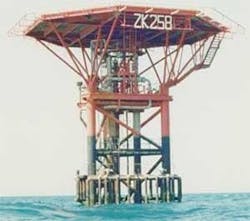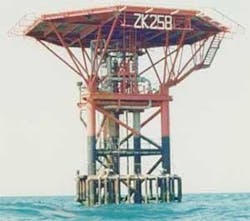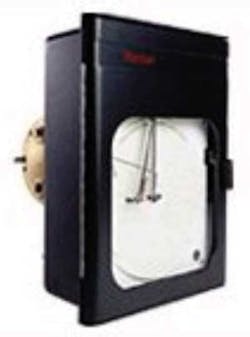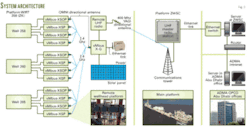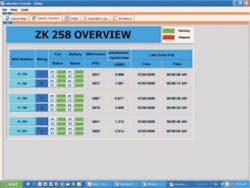Abu Dhabi Marine and Operating Co. (ADMA-OPCO) has embarked on a project with vMonitor to deploy a new generation wireless-sensor-network technology for monitoring continuously injection well surface pressure and flow rates.
These sensors, installed on each water-injection wellhead, are demonstrating substantial well operation and reservoir management benefits.
Water injection is common in many oil fields worldwide. The injected water can have two functions for improving recovery from oil reservoirs:
- Maintain reservoir pressure, allowing longer natural flow from wells.
- Displace oil in the reservoir and push oil towards producing wells.
Managing water injection, however, is important to ensure that the reservoir is not damaged. If unclean water enters the reservoir, particles can bridge off in the reservoir impairing injectivity and causing increased injection pressures. These pressures can fracture the reservoir, allowing injected water to enter unwanted zones. Or, if wells are offline, it can alter the sweep pattern of fluid flow and push oil in the wrong direction.
Successful injection management can provide 15-25% more oil recovery from the reservoir, providing the operator with much economic value.
Keys to successfully managing the injection include:
- Knowing when injection is shutdown (downtime tracking).
- Measuring the injection rate in each well.
- Monitoring (increasing) injection pressure.
- Immediate notifying when pressures are high enough to cause fracturing.
- Knowing when pressures drop below normal pressures (may indicate a leak).
ADMA operations
Today operators do not monitor continuously most water-injection wells. Monitoring requires wellhead instrumentation and remote connectivity to the office so that production and reservoir engineers can evaluate data continuously.
ADMA’s operations are entirely offshore. The company has more than 110 water-injection wells on about 26 platforms in Lower Zakum field (Fig. 1).
Currently, ADMA’s water-injection wells have conventional mechanical chart recorders (Fig. 2). To collect and replace the charts and forward them to headquarters, operations personnel make weekly helicopter trips. This operational process has several problems.
Weekly trips to about 26 platforms with helicopters are complex and expensive logistically. Also, data from these chart recorders require manual input before production and reservoir engineers can evaluate the data.
As a result, the current system has many limitations:
- Data are error prone because of manual evaluation of charts associated with manual data entry.
- Real-time data are unavailable to petroleum and reservoir engineers. This time delay can cause major well and reservoir problems.
- Operating expenses for monitoring and maintaining wells and collecting data are high.
Well monitoring options
The industry has had traditional supervisory, control, and data acquisition (SCADA) technology available for many years. ADMA has not installed this technology for monitoring its water-injection wells for several reasons.
Such systems are bulky for installation on platforms with limited topsides space. Also laying new cables on existing offshore platforms to connect the various sensors and instruments is complex and expensive.
Another cost prohibitive and time-consuming factor for installing SCADA is the running of subsea cables to facilitate data transmission between various platforms.
Providing power for a SCADA monitoring system on remote platforms is also problematic. Solar panels can provide power but require constant cleaning of bird excrement.
Key factors for ADMA in implementing a monitoring technology were:
- Wireless system with high reliability and accuracy.
- Battery-powered system that required neither an additional power source nor solar panels.
- Low-power system capable of transmitting data for several kilometers (5-10 km) to the nearest data gateway (hub).
- A system that the company could install quickly and easily with minimal disturbance of existing operations.
Implementing system
To automate the data gathering process from these water-injection wells, ADMA with vMonitor installed new generation wireless-sensor-network technology on several water-injection wells in Zakum West field.
Installation of these small hand-size sensors on water-injection wellheads is quick. The sensors measure surface wellhead pressure and water flow.
These sensors are in contrast to the traditional, bulky, and power-hungry SCADA remote terminal units, telemetry system, power system, and antennas.
Fig. 3 shows the system architecture.
These new generation wireless sensors (Fig. 4) have the advantages of:
- Long range (up to 10 km) communication, even when running on battery power. This allows the units to transmit data from the wells to a central gateway on a platform several kilometers away, where in turn another installed long-range radio transmits the data back to the main platform.
- High accuracy compared to mechanical chart recorders. The data measured and benchmarked against high-accuracy instruments (for pressure and flow) showed that these wireless sensors have more accuracy than conventional equipment, in many cases.
- The system demonstrated high degree or data transmission reliability and availability, even during adverse weather conditions.
Data reliability, accuracy
Main criteria for any system performance are data reliability and accuracy. A wireless sensor network involves relatively new technology. For this new technology to replace existing mechanical chart recorders, the system must demonstrate that it can deliver highly accurate measurements.
Before installation of the system, a benchmarking effort tested and validated the system’s reliability and accuracy.
The validation monitored measurements during 3 months. During that period, operations personnel collected data manually from mechanical chart recorders and compared the data against readings transmitted from the wireless sensors.
The wireless sensors had a minimum and maximum accuracy limit. The focus was more on observing the trends if they approached the minimum accuracy threshold.
A second performance criterion was the number of failures in data transmission.
Fig. 5 charts flow and pressure accuracy. The data indicate relatively high measurement accuracy for the wireless sensors compared with measurements from a mechanical chart recorder.
In some cases, the wireless sensor accuracy exceeded the measurement accuracy of the existing recorders.
Measured also was the reliability of the communication link and data availability during the same period. Table 1 summarizes one well’s reliability results.
Remote monitoring
The implementation of the wireless sensor network on the water-injection wells now allows ADMA reservoir engineers to monitor continuously the pressure and flow of these wells from their offices hundreds of miles away.
The wireless sensors transmit the data to vMonitor TotalAccess web-based software that provides the following features:
- Well overview performance screens (Fig. 6).
- Real-time well pressure and flow data and daily reports.
- Alarms and sensors for monitoring conditions at the well, such as the sensor battery condition.
Engineers use continuous live monitoring of water-injection flow rate and pressure for reservoir monitoring and simulation studies. This allows for better overall management of the reservoir for improving recovery. The system also allows production engineers to estimate the injected water amounts required to keep the reservoir producing oil.
Reservoir and petroleum engineers now can identify problems and act faster instead of having to wait for more than a week for information as with the present system of mechanical chart recorders.
Close monitoring of well performance trends can direct work activities to areas with identified problems and ensure that the problems are resolved before they expand and affect oil production.
The ADMA water-injection well monitoring and reservoir management system will move into the next phase of deployment in 2009.
The system has a wide range of implications on the ADMA’s Zakum reservoir management enhancement initiative. Better reservoir management requires better well data for improving water injection and control. This leads to better diagnostics for improved well screening and detection and correction of water entry points among other things.
Availability of such data to reservoir engineers will help them detect fracture problems and faults between injector and producing wells. Monitoring can help in early detection of a common problems such as leaks in well casing and tubing.
They may also detect other problems including coning when excessive water moves into the oil production zone.
Many other parameters carefully observed in the reservoir can significantly affect production. Better data are critical for improved reservoir diagnostics and is important for enhancing recovery that depends on oil displacement and sweep efficiency.
Reservoir engineers are now encouraging early intervention in water-injection control, whereas operations personnel traditionally did not interfere with the injection until a problem arose.
The authors
Majid Al Braik is a control engineer and has worked for Abu Dhabi Marine and Operating Co. (ADMA-OPCO) since October 2000. His main interests are advanced control systems and wireless communication. Al Braik holds a BE in engineering systems control from University of Huddersfield, UK, and an ME in advanced control systems from University of Manchester, UK.
Hatem Nasr is a cofounder of vMonitor. Before founding vMonitor, he was a director of technology at Baker Hughes Inc. He also worked for 11 years at Honeywell Technology Center where he held several positions including senior principal scientist and several research and management positions. He completed his PhD studies at the University of Minnesota in computer engineering, and obtained BS and MS degrees in systems engineering at the University of Houston.
Fahd Saghir is operations manager for vMonitor in UAE. He has managed several automation projects with various oil companies in UAE. He has a BSc in electrical engineering from the University of Houston.
